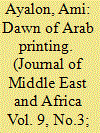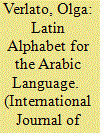|
|
|
Sort Order |
|
|
|
Items / Page
|
|
|
|
|
|
|
| Srl | Item |
| 1 |
ID:
163250


|
|
|
|
|
| Summary/Abstract |
The adoption of printing in the Ottoman Arab provinces in the nineteenth century portended a cultural transformation with profound implications, known as the nahda. Focusing on the Syrian town of Tripoli (Tarabulus al-Sham) as a case study, the article examines the historic cultural change from a peripheral vantage point. It looks at the impact of Arab printing and publishing, which evolved primarily in Cairo, Alexandria, and Beirut, on a community on the fringe of cultural change and examines its cultural interrelationship with these centers. Its findings show that, more than acting as mere consumers of print, Tripoli residents in substantial numbers took an active part in the discourse on social and cultural dilemmas which printing facilitated across the region, before adopting similar novelties in their own town toward the end of the century. The probe casts light on the manifold process by which printing, its products, and its diffusion mechanisms spread throughout the region. As printing was a key channel for circulating news and views, the study also affords a credible notion of the role that communities away from the production epicenters played in the nahda.
|
|
|
|
|
|
|
|
|
|
|
|
|
|
|
|
| 2 |
ID:
193489


|
|
|
|
|
| Summary/Abstract |
This article explores early attempts to romanize the Arabic language in late nineteenth and early twentieth-century Egypt and situates them within a global history of script reforms in the modern period. I focus on the models to write Arabic in the Latin script developed by the Cairo-based magazine al-Muqtataf between 1889 and 1897 (which, to the extent of my knowledge, have never been examined before), relating them to the responses they elicited from the magazine's readers and some of the romanization practices found in advertising, commercial displays in the streets, and governance at the time. I demonstrate that, in this period, romanized Arabic was envisioned as an original way to pursue financial profit and technological efficiency, confront European knowledge production, and redefine the standing of Arabic within transregional publishing networks that encompassed different languages and alphabets. This analysis thus offers an alternative geography of script reform that supersedes the national framework.
|
|
|
|
|
|
|
|
|
|
|
|
|
|
|
|
|
|
|
|
|